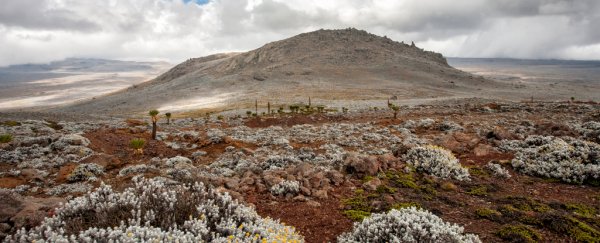What lengths would you go to if your survival truly depended upon it? Probably more than you give yourself credit for. Humans are versatile creatures, and throughout our history we've appeared in unexpected places, such as one mountainous area in Ethiopia 45,000 years ago.
Possibly due to a lack of water in the valleys, these ancient peoples scaled the Bale Mountains, drank from the melting glaciers, and ate the giant mole rats that lived there.
Until recently, we thought that human habitation of Alpine regions only occurred late in human history. After all, the low oxygen levels and unpredictable temperatures would make someone think twice before setting up camp at altitudes higher than 4,000 metres (13,000 feet).
But new research from an international team suggests that our ancestors weren't too bothered by these heights, having set up camp in the mountains during the Palaeolithic (or Stone Age) period.
That also just happens to be towards the end of the last glacial period, also known as the last ice age.
"We present the results of combined archaeological, soil biogeochemical, glacial chronological, and zoogeographical analyses," the team explains in their new study.
"We describe the world's oldest occupation of a residential site at high elevation, which was repeatedly inhabited by humans who exploited a glaciated African ecosystem."
The team investigated a rock shelter called Fincha Habera, and five outcrops where obsidian was likely mined, all 4,000 metres above sea level in southern Ethiopia. All of the outcrops showed ample evidence of human habitation long past.
In Fincha Habera, the team found a number of stone artefacts, pottery shards, fragments of rodent bones and ostrich eggs, and a glass bead.
And that's not including the huge amount of what are likely to be human faeces.
"Over several millennia, Fincha Habera was repeatedly used as a residential site," the team writes.
"This function is indicated by the density of archaeological materials, the existence of hearth remains and the use of fire, the massive presence of human faeces, the simultaneous manufacture and intense use of predominantly locally derived lithic artefacts, and the preparation and consumption of food."
Carbon dating showed the earliest artefacts at the site were likely between 47,000 and 31,000 years old – a time when the last glacial period or last ice age was well in effect.
Glaciers would have been nearby, potentially providing flowing water. The researchers explain that a reliable and persistent source of surface water nearby, is suggested by the concurrent nearby presence of beetles that rely on a humid environment.
The team thinks these ancient humans would have used Fincha Habera as a type of base camp, drinking water from the glaciers, making stone age tools out of obsidian, and eating giant mole rats for sustenance.
It's important to note that this isn't the oldest hominin occupation of these high-altitude habitats. That honour goes to a group of Denisovans who researchers think lived 4,600 metres high on the eastern slopes of the Tibetan Plateau, as long as 160 thousand years ago.
There's also evidence that Homo sapiens had at least short-term stays at 4,600 metres above sea levels, but nothing else quite this long term.
This makes Fincha Habera the world's oldest known high-altitude human residential site – a record not to be sniffed at.
And the ice age wasn't the only time humans have lived in the area. According to soil samples around 10,000 years ago a new occupation began – this time instead of mole rats, the researchers found evidence of grazing animals.
Humans really can be amazing.
The research has been published in Science.
